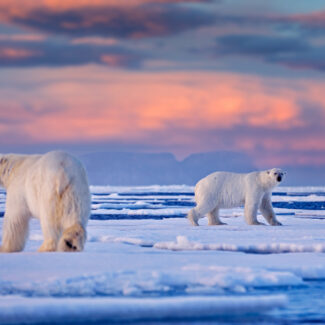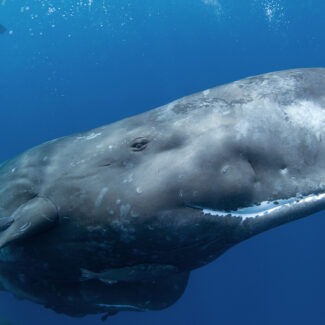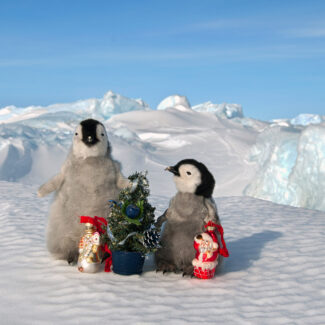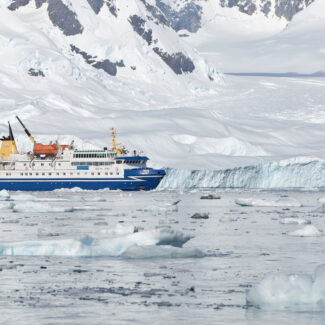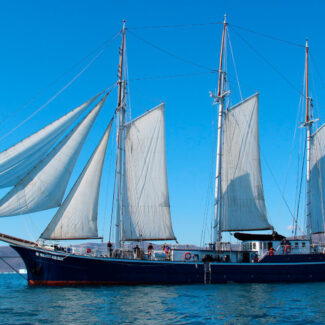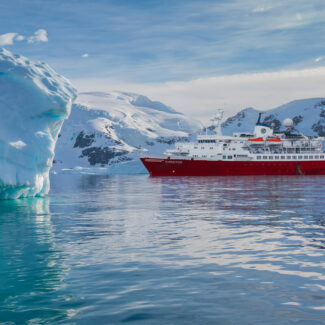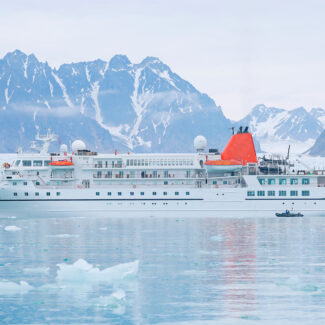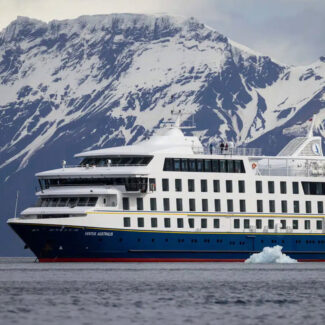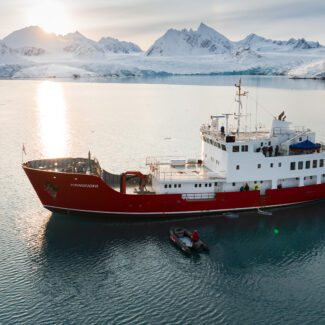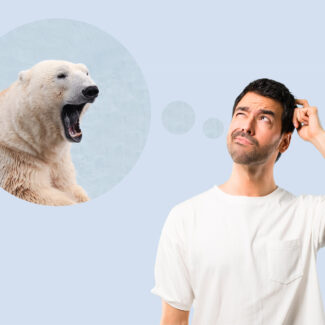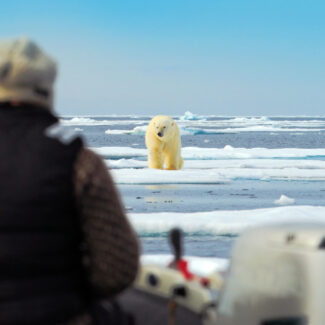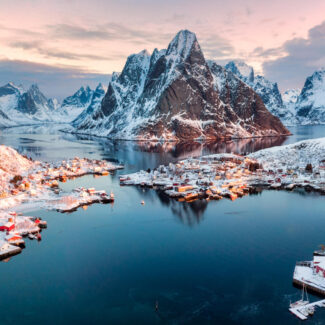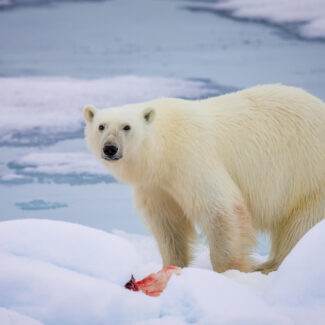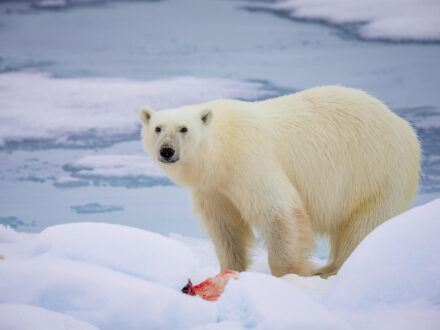Beyond the Beak: 8 Fascinating Puffin Facts
- (1) There Are Three Species of Puffins: Two in the Pacific Basin, One in the Atlantic
- (2) They Form Large Nesting Colonies on Islands & Coastal Cliffs, and Otherwise Spend Their Lives Out to Sea
- (3) Iceland is Home to More Than Half the Global Population on Atlantic Puffins
- (4) The Puffin Beak is Among the Most Colorful in the Avian World—and Superbly Designed to Pin Fish
- (5) Fish Are a Mainstay of the Puffin Diet, But These Birds Eat a Wide Variety of Other Small Prey
- (6) They’re Long-Lived & Far-Traveling Birds
- (7) Atlantic Puffins Have Been Documented Using Tools
- (8) They Face a Perilous Future
- Where to See Puffins
Puffins are likely on the shortlist of the world’s most universally endearing critters (though we must be careful, of course, to acknowledge that less intrinsically endearing organisms are just as important and worthy of respect). Resembling a mashup of a penguin and a parrot—indeed, they’re often called “sea parrots”—puffins are instantly recognizable and highly coveted by both hardcore and more casual birdwatchers.
The handful of puffin species belong to a family of seabirds called the alcids, all very roughly sharing a squat, stubby bodyplan and a predominantly oceanic lifeway that sees them come ashore only to nest. Other alcids include guillemots, murres, murrelets, razorbills, dovekies, and auklets. (Another noteworthy member of the family, the great auk—a flightless, penguin-like bird that was by far the largest modern alcid and overlapped in range with the Atlantic puffin—was killed off by humans in the 1800s, going the way of the dodo, the passenger pigeon, and the thylacine, among other unfortunate species.)
Puffins edge into the southern fringe of the Arctic here and there, otherwise being found mainly in subarctic and cold-temperate seas. Let’s learn more about these sea parrots and “clowns of the sea” via the following eight puffin facts!
Beyond its iconic beak, the Atlantic Puffin holds many fascinating secrets. Prepare to discover surprising facts about this beloved seabird and its unique adaptations to life at sea!
(1) There Are Three Species of Puffins: Two in the Pacific Basin, One in the Atlantic
Puffins favor cold northern-temperate and subarctic waters and are restricted to the Northern Hemisphere. (South of the equator, they’d probably get in trouble with penguins, who might feel their status as No. 1 Cutie-Pie Seabird threatened.)
The Atlantic puffin is the sole puffin species in its namesake basin, occupying the North Atlantic from eastern Canada and the northeastern U.S. to northwestern Europe. It’s also the smallest kind of puffin, typically weighing less than a pound and running about a foot in length. While most of their range is south of the Arctic Circle, Atlantic puffins do breed quite far north in Svalbard, Greenland, and northeastern Canada, and Iceland (as we’ll see) is a hotspot for the species.
The other two puffins inhabit the North Pacific. The horned puffin—named for fleshy protuberances above the adults’ eyes during breeding season—is notably larger than the Atlantic puffin and has a longer tail; it’s found widely from eastern Russia to the northwestern U.S., occupying much of the Bering Sea and also extending into the Chukchi Sea (nesting, notably, on Wrangel Island, for example).
Much of that range overlaps with that of the tufted puffin, the biggest puffin of all, which may weigh 1.7 pounds and, in breeding season, sports flashy yellow head feathers that give it its name. Tufted puffins range a bit farther south than horned puffins in the North Pacific, but, again, there’s much overlap in both breeding and wintering grounds.
With its distinctive yellow plumes, the Horned Puffin is one of two species found in the Pacific Basin. Its unique appearance highlights the diversity among the world’s three captivating puffin species.
(2) They Form Large Nesting Colonies on Islands & Coastal Cliffs, and Otherwise Spend Their Lives Out to Sea
Like many seabirds, puffins nest in large colonial rookeries, and favor for their location predator-free coastal cliffs and, especially, islands and sea stacks. Atlantic and tufted puffins typically nest within burrows they excavate into soil; horned puffins will occasionally use burrows, but more commonly they nest directly on rocks and sea-cliff ledges. Normally the female puffin lays a single egg, which hatches to produce what’s endearingly known as a “puffling.”
After offspring fledge, puffins depart those bustling nesting colonies and the mainly nearby waters they’ve been foraging in and head widely out to sea. They commonly spend the winter far offshore, including way out in the mid-ocean over very deep water indeed. They tend to be found in much smaller groups during this time of year, and sometimes simply as solitary pelagic wayfarers. And while puffins issue low-pitched groans and moans at their colonies, they tend to be completely silent wintering in the open ocean.
Observe a thriving Atlantic Puffin nesting colony, a sight that defines their life cycle. These remarkable birds gather on coastal cliffs like these for breeding before returning to their solitary lives at sea
(3) Iceland is Home to More Than Half the Global Population on Atlantic Puffins
Iceland might rightly be considered the puffin capital of the world: More than half the global population of the Atlantic puffin, some eight to 10 million birds, nests here. Indeed, visitors to the capital of Reykjavik can see a puffin colony just a hop, skip, and a jump from the city.
But the greatest of all the island’s puffin colonies—and, indeed, the largest rookery of Atlantic puffins in the world—is found in the archipelago of Vestmannaeyjar, aka the Westman Islands. Seeing this multitude of “sea parrots,” mainly resident from May to late August or early September, is a bucket-list item for many a birder!
Incidentally, puffins used to breed more widely on the mainland of Iceland, which historically lacked terrestrial predators, but the introduction of the non-native American mink decimated these colonies and now most of the country’s nests are found on offshore isles.
(In North America, meanwhile, the most significant Atlantic-puffin colony is found in Newfoundland’s Witless Bay, where better than 260,000 breeding pairs nest.)
Perched majestically on an Icelandic cliff, this Atlantic Puffin represents the vast numbers of its kind thriving here—Iceland is home to over half the global population, a truly significant fact for these iconic birds.
(4) The Puffin Beak is Among the Most Colorful in the Avian World—and Superbly Designed to Pin Fish
The bills of adult puffins during the breeding season are downright dazzling, among the flashiest wielded by any seabird. The Atlantic puffin’s breeding bill has a blueish base with an orange point, while that of the horned puffin has a broad yellow base and a reddish-orange tip. The tufted puffin’s bill has a narrow yellowish base and more extensive reddish-orange. Set against the white cheeks all three puffin species wear in breeding plumage, these colorful beaks are all the more eye-popping, and the whole facial getup explains the “clown of the sea” tag.
Puffins shed the outer layers of the beak that encompass those flashy hues for the winter nonbreeding season, so their bills appear duller (though still yellowish or orangeish) and narrower. The birds also lose the pure white markings on their face during the winter, with dusky cheeks instead.
Those puffin bills are more than multicolored marvels: They’re also supremely good at snatching and holding fish. A hingelike fit and outward-canted spines within the mouth help secure slippery prey, multiples of which may be carried crosswise at a time. A horned puffin was once counted with a whopping 65 fish at once in its bill, while an especially ambitious Atlantic puffin was seen hauling an even more whopping 83 sandlances in one go. You can imagine that adult puffins can bring quite the haul from the brine back to the nest for that puffling of theirs!
The striking beak of the Atlantic Puffin isn’t just colorful; it’s perfectly designed to hold multiple fish at once, showcasing one of nature’s most effective fishing tools
(5) Fish Are a Mainstay of the Puffin Diet, But These Birds Eat a Wide Variety of Other Small Prey
During the breeding season, puffins primarily carry small fish back to the nest. Atlantic puffins, for example, commonly catch sandlance, capelin, herring, sprat, and cod, among other fishes. Wintering offshore, puffins not only feed on fish but also euphausiids and other crustaceans, squid, and marine worms. Among the pelagic fishes taken by horned and tufted puffins are lanternfish, which are bioluminescent and spend the day in the dark depths; lanternfish swim closer to the surface at night, suggesting these puffins are not opposed to active foraging after-hours.
These fish and other prey are taken by pursuit-diving: Ungainly as they might look coming in for a landing (and waddling about on the ground), puffins are masterful and agile underwater, propelling themselves with their curved and rounded wings. The deepest-diving puffin, the tufted, has been recorded going down to 360 feet below the sea surface.
With a fresh catch in its beak, this Puffin demonstrates its reliance on fish. Yet, these birds enjoy a varied diet of small prey, highlighting their adaptability in foraging.
(6) They’re Long-Lived & Far-Traveling Birds
Puffins have impressive lifespans, often on the order of 20 years or more. One banded Atlantic puffin was documented to be 41 years old (and still going strong). Young puffins take several years to reach sexual maturity: They may not breed until they’re five or six years old in some cases.
Puffins are also impressively far-traveling seabirds despite their stubby-looking bodies and proportionately smallish wings. A male Atlantic puffin tagged on Maine’s Seal Island made wintering journeys as far south as Bermuda and as far north as the northern reaches of the Labrador Sea over the course of two years. And young puffins marked in Europe and Iceland have shown up in eastern Canada.
Perched by the sea, this Atlantic Puffin embodies resilience. These birds are known for their long lives and incredible journeys, traveling vast distances across the ocean.
(7) Atlantic Puffins Have Been Documented Using Tools
In 2019, a study published in PNAS suggested Atlantic puffins are the first seabirds yet documented to use tools. Two puffins in widely disparate breeding colonies—one in Wales, the other Iceland—were observed picking up a stick and scratching themselves with it. While these are just two observations, the fact that they hail from such geographically distinct locations suggests such tool use may be inherent and widely found in the species—though there’s still much to learn about the subject.
This Atlantic Puffin, carrying nesting material, reminds us of a surprising fact: these birds have been observed using tools! It highlights their intelligence and resourcefulness in the wild.
(8) They Face a Perilous Future
Estimates of global breeding puffin populations range from about 800,000 for the horned puffin to 2.3 million tufted puffins and perhaps 12 million Atlantic puffins. In other words, puffins are pretty numerous, but that doesn’t mean conservationists aren’t worried about them. Overhunting and egg-harvesting have been a problem for the Atlantic puffin in the past and bycatch via the fishing industry has been a mortality factor for horned and tufted puffins, though the situation on that front has improved. All three puffin species, however, may face serious issues from warming ocean waters associated with climate change.
This phenomenon is thought to have already halved some of southern Iceland’s puffin colonies over the past 20 years—including the world’s largest colony in the Westman Islands (Vestmannaeyjar)—thanks to a drastic decline in their main food source: sandeels (Ammoditytes marinus). Sandeels thrive in cooler ocean temperatures (around 7.1°C), but the rising sea surface temperatures around southern Iceland, influenced by warm periods in the Atlantic, are decimating sandeel populations by stunting growth rates, affecting reproduction, and their ability to survive the winter.
These Atlantic Puffins gathered on their breeding grounds highlight a pressing concern: their future is increasingly perilous due to environmental challenges. Supporting conservation efforts is crucial for these remarkable birds.
Where to See Puffins
Your best chances, by far, to spy puffins come during the breeding season. (The chances of spotting wintering puffins out in the ocean will inevitably be hit-or-miss, and generally would come via strategic “seawatches” or, better yet, pelagic birding cruises.) We’ve already talked up Iceland as a puffin-watching hotspot; it’s certainly one of the best places in the world to observe these clowns of the sea. But birding or ecotourism cruises in a variety of other places—including Arctic routes to, for example, Svalbard, Greenland, and Canada—may include puffin rookeries in the itinerary.
Disclaimer
Our travel guides are for informational purposes only. While we aim to provide accurate and up-to-date information, Antarctica Cruises makes no representations as to the accuracy or completeness of any information in our guides or found by following any link on this site.
Antarctica Cruises cannot and will not accept responsibility for any omissions or inaccuracies, or for any consequences arising therefrom, including any losses, injuries, or damages resulting from the display or use of this information.




